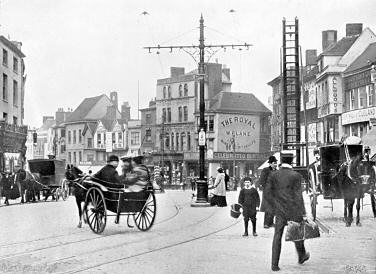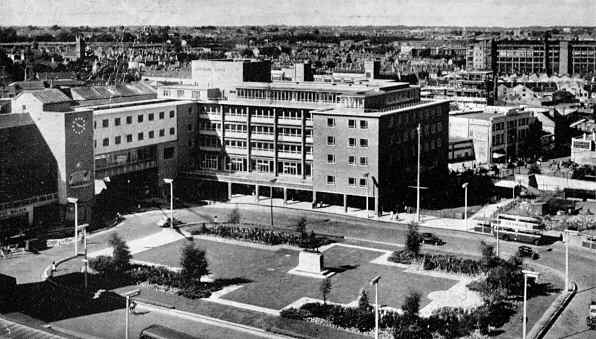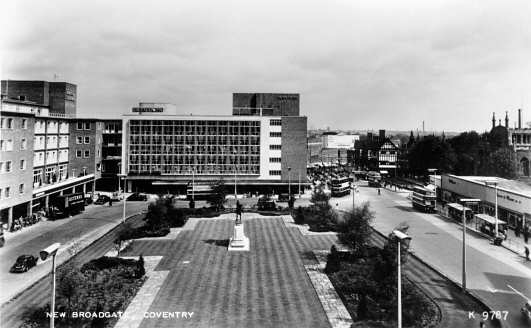|
Index...
|

 s one of the first reconstruction projects to be completed after the war, Broadgate was undoubtedly the centrepiece of Coventry's Phoenix-like rise from the ashes. From a narrow street which had undergone widening in a Victorian era 'modernisation', (see early 1900s photo, left) it was now to be changed out of all recognition, and the artist's impression below depicting the war-time vision of the new Broadgate shows how the architects stuck quite closely to their original plan.
s one of the first reconstruction projects to be completed after the war, Broadgate was undoubtedly the centrepiece of Coventry's Phoenix-like rise from the ashes. From a narrow street which had undergone widening in a Victorian era 'modernisation', (see early 1900s photo, left) it was now to be changed out of all recognition, and the artist's impression below depicting the war-time vision of the new Broadgate shows how the architects stuck quite closely to their original plan.

This 1953 postcard view shows us a significant snapshot of the completion of the first stage in Broadgate's surrounding buildings. Broadgate House (centre of the photo) was opened in May of that year and on the 1st October the following year Owen Owen officially opened on the other side of the "island" (see the photo below).
The "square", including the garden island, had been established long before this time, having been opened by Princess Elizabeth (later the Queen) on the 22nd May 1948. This was followed by the unveiling of William Reid Dick's £20,000 bronze Godiva statue on the 22nd October 1949. By 1955 the Hotel Leofric and the upper end of the Precinct had also reached completion and the new Coventry was beginning to take shape.
The postcard below can be dated to 1955 from several facts: - Firstly, the inclusion of a completed Leofric Hotel on the left, and secondly, a close-up of the photograph reveals the theatre in the background still with the "Hippodrome" lettering on the side.... later that year the name was changed to "The Coventry Theatre".

Many people born before about 1970 will fondly remember the temporary shops which lined the east side of Broadgate and were fronted by many bus stops. Certainly my own earliest memories of town were my mum and dad taking me for a cup of tea and a chocolate cup-cake in the well known Lyons' cafe! Built in 1947, these shops with their corrugated fronts were only meant to have a life of a few years - but in the end they were not demolished until March 1974.

Temporary or not, I doubt if the modern Cathedral Lanes shopping centre now occupying the square will be talked of in the same endearing terms as those shops. In my opinion, the Broadgate garden island was one of the things that the town planners definitely got right after the war - which makes it even harder to comprehend just why they chose to destroy it around 1990.
Going back to 1974, the demolition of the east side of Broadgate gave Margaret Rylatt and the Coventry archaeologists a unique opportunity to excavate the area in an effort to determine its history back to medieval times. Many artefacts were discovered and they were able to piece together a lot of data in order to build up a partial picture of everyday life through the centuries. However, much more could have been learned if the foundations and modern services of pre-war buildings hadn't already destroyed the labyrinth of medieval structures of which only fragments now remain below ground.
For a page dedicated to Broadgate through the ages, please take a look at Now and Then - Broadgate Special
Website by Rob Orland © 2002 to 2026